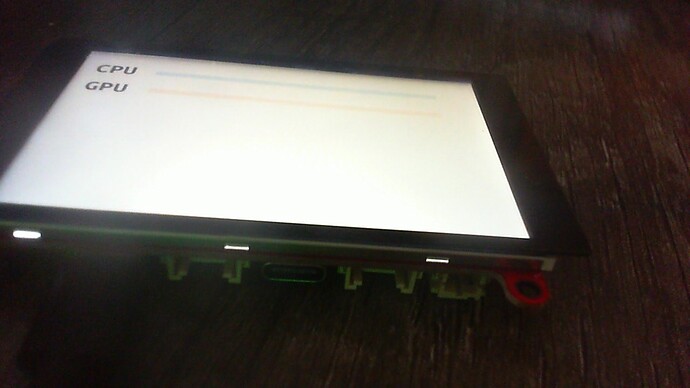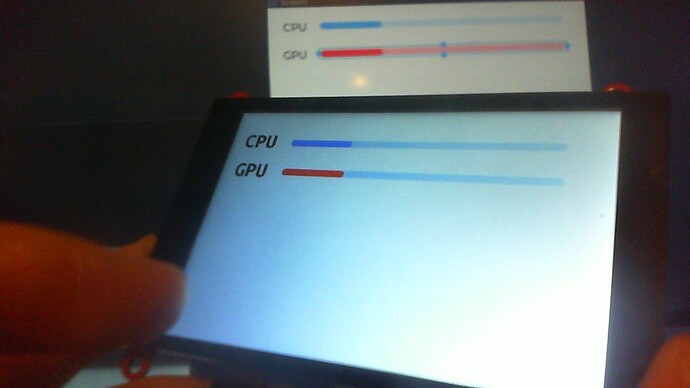LVGL is not reflecting the values I set the Bars to in the UI, after the initial value is set. The initial value is all that is ever displayed.
Platform
ESP32S3. Specifically the Makerfabs Parallel ESP Display S3
Version
I’m using LVGL 8.2.0, because that’s what Squareline lets me use
What I would like
I want LVGL to actually update the UI when I tell it to!
I’ve got my code below.
I’ve omitted ui.h because it’s just boilerplate squareline stuff to put two bars on the screen. ui_CpuBar, and ui_GpuBar. If you want to reproduce that code, simply drag two bars into squareline and name them accordingly and then export. Bam. You have your ui.h
Code to reproduce
// define this for less flicker:
#define DOUBLE_BUFFER
#include <Arduino.h>
#include <lvgl.h>
#include "ui.h"
#include "ui_patch.h"
// TFT_eSPI doesn't work with 16-bit i8080
// LoyvanGFX performs like hot wet garbage on an S3. I wrote my own driver. It works.
#include "lcd_controller.h"
#include "FT6236.h"
#define get_pos ft6236_pos
#define I2C_SCL 39
#define I2C_SDA 38
#define LCD_BLK 45
#define LCD_H_RES 480
#define LCD_V_RES 320
// change this to control display RAM use:
#define LVGL_LCD_BUF_SIZE (LCD_H_RES * 32)
static lv_disp_draw_buf_t disp_buf; // contains internal graphic buffer(s) called draw buffer(s)
static lv_disp_drv_t disp_drv; // contains callback functions
static lv_color_t *lv_disp_buf;
#ifdef DOUBLE_BUFFER
static lv_color_t *lv_disp_buf2;
#endif
static bool is_initialized_lvgl = false;
/*Read the touchpad*/
void touch_read( lv_indev_drv_t * indev_driver, lv_indev_data_t * data )
{
int pos[2];
if(get_pos(pos)) {
data->state = LV_INDEV_STATE_PR;
if(LCD_H_RES>LCD_V_RES) {
data->point.x = pos[1];
data->point.y = pos[0];
} else {
data->point.x = pos[0];
data->point.y = pos[1];
}
} else {
data->state = LV_INDEV_STATE_REL;
}
}
static bool lvgl_flush_ready(esp_lcd_panel_io_handle_t panel_io, esp_lcd_panel_io_event_data_t *edata, void *user_ctx) {
lv_disp_flush_ready((lv_disp_drv_t *)user_ctx);
return true;
}
static void lvgl_flush(lv_disp_drv_t *drv, const lv_area_t *area, lv_color_t *color_map) {
lcd_flush(area->x1,area->y1,area->x2,area->y2,color_map);
}
void setup() {
Serial.begin(115200);
Wire.begin(I2C_SDA, I2C_SCL);
lcd_color_trans_done_register_cb(lvgl_flush_ready,&disp_drv);
lcd_init(LVGL_LCD_BUF_SIZE*sizeof(lv_color_t));
/* Lighten the screen with gradient */
ledcSetup(0, 10000, 8);
ledcAttachPin(LCD_BLK, 0);
for (uint8_t i = 0; i < 0xFF; i++) {
ledcWrite(0, i);
delay(2);
}
lv_init();
#ifdef DOUBLE_BUFFER
lv_disp_buf = (lv_color_t *)heap_caps_malloc(LVGL_LCD_BUF_SIZE * sizeof(lv_color_t)/2, MALLOC_CAP_DMA | MALLOC_CAP_INTERNAL);
if(lv_disp_buf==NULL) {
Serial.println("Out of memory");
while(1);
}
lv_disp_buf2 = (lv_color_t *)heap_caps_malloc(LVGL_LCD_BUF_SIZE * sizeof(lv_color_t)/2, MALLOC_CAP_DMA | MALLOC_CAP_INTERNAL);
if(lv_disp_buf2==NULL) {
Serial.println("Out of memory");
while(1);
}
lv_disp_draw_buf_init(&disp_buf, lv_disp_buf,lv_disp_buf2,LVGL_LCD_BUF_SIZE/2);
#else
lv_disp_buf = (lv_color_t *)heap_caps_malloc(LVGL_LCD_BUF_SIZE * sizeof(lv_color_t), MALLOC_CAP_DMA | MALLOC_CAP_INTERNAL);
if(lv_disp_buf==NULL) {
Serial.println("Out of memory");
while(1);
}
lv_disp_draw_buf_init(&disp_buf, lv_disp_buf,NULL,LVGL_LCD_BUF_SIZE);
#endif
/*Initialize the display*/
lv_disp_drv_init(&disp_drv);
/*Change the following line to your display resolution*/
disp_drv.hor_res = LCD_H_RES;
disp_drv.ver_res = LCD_V_RES;
disp_drv.flush_cb = lvgl_flush;
disp_drv.draw_buf = &disp_buf;
disp_drv.user_data = NULL;
lv_disp_drv_register(&disp_drv);
static lv_indev_drv_t indev_drv;
lv_indev_drv_init( &indev_drv );
indev_drv.type = LV_INDEV_TYPE_POINTER;
indev_drv.read_cb = touch_read;
lv_indev_drv_register( &indev_drv );
is_initialized_lvgl = true;
ui_init();
// fix what Squareline didn't export correctly
ui_patch();
}
void loop() {
lv_timer_handler();
delay(5);
// nothing happens!
lv_bar_set_value(ui_CpuBar, 25, LV_ANIM_OFF);
lv_bar_set_value(ui_GpuBar, 50, LV_ANIM_OFF);
lv_obj_invalidate(lv_scr_act());
}
Screenshot and/or video
expected should be something a bit like:

